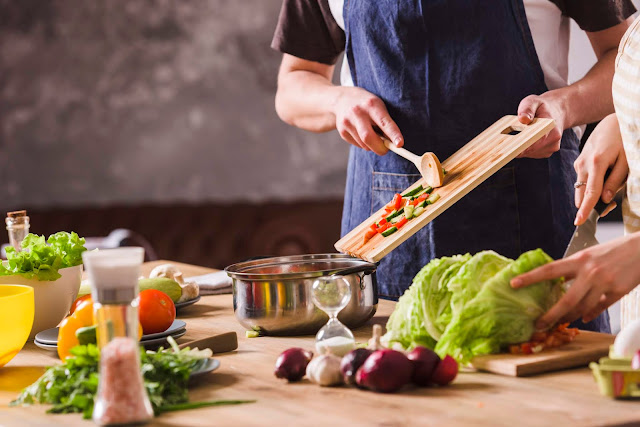Ayurvedic Healthy Diet Principles
Ayurvedic Principles of Cooking
INTRODUCTION:
Ayurvedic cooking is a way of caring that gives complete
satisfaction.
Ayurvedic foods are appetizing, flavourful and aromatic and
a way of offering love, becoming healing when served in an inspiring atmosphere.
OBJECTIVE:
Releasing toxins that have entered the body and the
electrochemical vitalising of the body are main objectives. Ayurvedic cooking
is an art and a science at the same time, when cooking becomes alchemy and food
becomes Tantra.
The basic principles of Ayurvedic Cooking are:
1. The five Elements
2. The three Doshas: According to Ayurveda we are either one
or a combination of two or all three doshas (body constitutions): vata
(air/ether), pitta (fire) and kapha (earth/water). When you eat according to
your constitution equilibrium is maintained in your body.
3. The three Gunas
4. The seven Dathus
5. The six Tastes: Sweet, sour, salty, pungent, astringent
and bitter. Meals having all these tastes are satiating and flavourful.
Practice these
simple methods when cooking your meals.
1. Food
should be light, easy to digest and to assimilate.
2. The
largest meal should be at lunchtime, when you have the support of the sun.
3. Use
spices intelligently to balance the doshas.
4. Calming
spices are ginger, cumin and cardamom.
5. Warming
spices are turmeric, cinnamon, and mustard.
6. Soothing
spices are coriander, fennel, and salt.
7. Cooked
food is easier to digest than raw food.
8. Certain
foods do not go well with others. Specifically, cow’s milk does not go well
with citrus fruits or banana. Yogurt and banana are also incompatible.
Recommended Timing
• Intake of
six rasas or tastes. At each meal, you will incorporate foods that are sweet,
salty, sour, bitter, pungent and astringent. You begin your meal with foods
that have a sweet taste (like sweet fruit), then consume food that is salty
(such as seafood) and sour (citrus fruit, for example), then finish with foods
that are pungent (like onions or peppers), astringent (such as green apples or
tea), and bitter (celery, kale, or green leafy vegetables).
• Eat
mindfully and with concentration. Avoid other distractions to fully appreciate
your meal and the wholesome benefits it provides.
• Eat
slowly so that you can savor the taste of the food.
• Eat warm
food.
• Eat the proper quantity of food. Be
aware of hunger signals and signs of fullness to avoid overeating.
• You
should not eat within three hours of your previous meal or snack and you should
not go without food for more than six hours.
COOKING METHODS AND BALANCED FOOD
Sattvic food – Food that is primarily whole foods, plant
based, lightly spiced and with no oil.
Well-balanced – Indigestion and lack of energy after a meal
is more often an imbalance in the combinations and proportions of proteins,
carbs and fat. A balanced meal will boost energy and vitality.
Healthy variety – Meals prepared using a variety of
vegetables, roots, greens, fresh herbs, whole grains, lentils, beans, nuts,
seeds, dried fruits and spices all provide the body complete range of
nutrients.
Fresh, local and organic – Eating freshly picked organic
produce from the local farmer’s market helps your local economy, helps create a
community and ensures that you get the best and freshest food that tastes the
best that it can and is full of all the nutrients.
Seasonal – Eating seasonal fruits and vegetables helps you
keep in sync with the cycles of nature. For example, your desire to eat more
fresh green, hydrating vegetables in the summer complements the optimum season
for these vegetables just as your desire for dense warming vegetables like
winter squash and beets coincides with its abundance in the colder climates.
Cooking tools – It’s important to take into consideration
the utensils and equipment you cook with. They have to be as natural as
possible. Plastic, aluminum, non-stick, anodized cooking utensils may leech
toxins into the food so using stainless steel, wood, cast iron, ceramic or
glass is the safest.
Avoiding tamasic food – Avoid food prepared using plastic,
aluminum, non-stick and anodized steel utensils; food that is microwaved,
canned or pre-made; food containing processed and refined ingredients like
oils, white flour, white sugar, salt and sugar substitutes, corn syrup,
preservatives, artificial flavouring, artificial colouring, packaged or stored
in plastic containers or aluminum.
Cooking method – Cook food only to the extent to make it
digestible, while retaining most of its nutritive value.
Following certain cooking processes to retain the nutrients,
such as steaming vegetables, soaking and sprouting beans and lentils and rinsing
grains well before cooking.
Preparing a meal with a positive intention, love and healing
vibrations, mantras and prayers makes it even more potent and rich with healing
properties.



Comments
Post a Comment